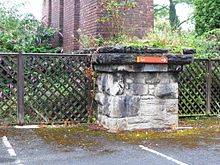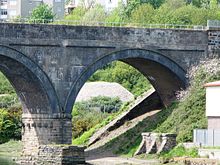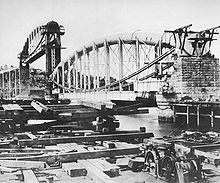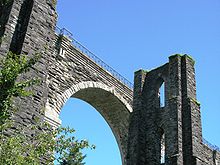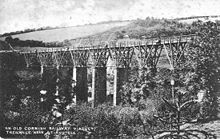- Cornwall Railway viaducts
-
This article is about viaducts built by the Cornwall railway Company (1859 to 1889). For viaducts built by other railway companies in Cornwall, see List of railway bridges and viaducts in the United Kingdom.
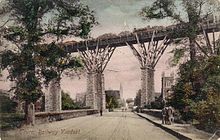 The 70 miles (110 km) of the Cornwall Railway included 42 wooden viaducts, such as Carvedras viaduct in Truro
The 70 miles (110 km) of the Cornwall Railway included 42 wooden viaducts, such as Carvedras viaduct in Truro
The large number of Cornwall Railway viaducts were necessitated by the topography of Cornwall, United Kingdom, where hills and areas of high ground are separated by deep river valleys that generally run north or south. However the Cornwall Railway was constructed on a largely east-west route between the towns of Plymouth, Truro and Falmouth, so it had to cross numerous valleys.
42 wooden viaducts of a distinctive type were built by contractors, most to a series of standardised designs by the Victorian railway engineer Isambard Kingdom Brunel. They consisted of timber deck spans supported by fans of timber bracing built on masonry piers. This unusual method of construction substantially reduced the cost of initial construction compared to an all-masonry structure, albeit at the cost of more expensive maintenance. Replacement of the timber viaducts by all-masonry structures began in the 1870s but a few remained in service until the 1930s.
Contents
History
The Cornwall Railway linked Plymouth with Falmouth. The section from Plymouth to Truro was opened on 4 May 1859, and the remainder to Falmouth on 24 August 1863. This was after Brunel's death and so was built under the supervision of R P Brereton. It was built as a single-track 7 ft 0 1⁄4 in (2,140 mm) broad gauge line.
The 70 miles (110 km) of railway crossed 45 rivers and deep valleys. Of these 43 were spanned by viaducts of various types built partly or entirely from timber. Workshops were established at Lostwithiel where timber could arrive on barges to be preserved and cut to size. The offcuts from the timbers used for the viaducts and track were then used for the construction of the railway's buildings.[1] The choice of timber was made to keep initial costs down, but Brunel realised that this meant more expensive maintenance and eventual replacement would become necessary. Replacement of the viaducts started in 1875 but led to a dispute in 1884 between the Cornwall Railway and the Great Western Railway which was leasing the line. The lease precluded the conversion of the line to 4 ft 8 1⁄2 in (1,435 mm) standard gauge, and the Cornwall Railway refused to pay for the widening of the viaducts during rebuilding sufficient to accommodate a double line of standard gauge tracks. Following the amalgamation of the two companies on 1 July 1889 all the remaining viaducts were replaced. Most were either rebuilt in situ or by a replacement viaduct built immediately alongside. Because of this, many of Brunel's original piers still remain today. Those between Saltash and St Germans being were by a deviation line in 1908, which eliminated the wooden viaducts on the main line to Truro. Those on the Falmouth branch were all replaced between 1923 and 1934.[2]
Constructional features
The distinctive timber viaducts were constructed using yellow pine which was preserved by Kyanising (using chloride of mercury), or sometimes by Burnettising (using chloride of zinc) in the workshops at Lostwithiel. The various timbers were seated in cast iron chairs, and wrought iron was used for parts of the bridge which would be in tension, such as tie rods between spans.[3] Five distinct types of viaduct were built to suit local conditions at each site. Peter John Margary, the Cornwall Railway engineer from 1868 to 1891,[4] classified them as classes A to E.
- Class A: The majority of viaducts were constructed on stone piers that rose to about 34 feet (10 m) below track level. From the tops of these radiated three fans of timber struts to support the beams beneath the track; one fan on each side and the third beneath the centre of the track. The struts radiated at around 55, 75, 105 and 125 degrees from horizontal (resulting in a \\// form), although there were some slight variations. This gave piers spaced at about 65-foot (20 m) centres.[5]
- Class B: A stronger support was given to St Pinnock, Largin, and Ponsanooth viaducts by replacing the central set of fan struts with a pair. These joined the outer fans at the top of the pier and met each other at the top, giving a W form when viewed across the width of the piers.[6]
- Class C: The soft ground of the tidal valleys at Weston Mill, Forder, Wivelscombe, and Nottar required a lighter structure. This was achieved by dispensing with the stone piers and replacing them with vertical timber trestles built on top of timber piles driven into the mud. There were no fans supporting the track, instead timber trusses were built directly on top of the timber trestles.[7]
- Class D: Coombe (by Saltash) and Moorswater viaducts had only two fans on each pier - one on each side - but the bottoms of these were joined by laminated timber beams between each set of fans, which created a continuous beam along the length of the viaduct above the top of the masonry piers.[8]
- Class E: The shallowest valleys at Grove, Draw Wood, and Probus were crossed by simple trestles of three parallel fans with two struts each in a V shape.[9]
Brunel's designs allowed any defective timber to be withdrawn and replaced. The first decay usually occurred at the bottom of legs where they were seated in the cast iron chairs, and around bolt holes. The other area with significant decay was generally underneath the decking that carried the track and ballast. After World War I it became difficult to obtain the preferred yellow pine and other timber with shorter life was used instead, although by this time only the viaducts on the Falmouth branch remained in use.[10]
Special gangs of men worked together on the viaduct maintenance. To reach timbers below the deck they worked from 2.5 inches (64 mm) manila ropes. It was possible to work on the viaduct without closing the viaduct to trains, but a temporary 10 miles per hour (16 km/h) speed restriction was enforced until the replacement was properly in place. The actual movement of the larger timbers was carried out on a Sunday when there were few trains operating.[10]
Viaducts from Plymouth to St Germans
Stonehouse Pool
Milepost 247.25 on original Millbay to Devonport line between Five Fields Lane (now North Road West) and Stuart Road, 1-mile (1.6 km) south of Devonport station. (50°22′37″N 4°09′00″W / 50.376835°N 4.150043°W)
The only double track viaduct on the line, it was a Class A viaduct but with five fans of struts on each of the dwarf piers. It was 57 feet (17 m) high and 321 feet (98 m) long on 5 dwarf piers. Rebuilt with iron girders on brick piers in 1908, the girders have since been removed and a steel work of art has been erected in its place.[11]
The land below the viaduct was the head of a tidal creek but is now drained and forms a park.[12] In 1876 a new Cornwall Loop between Plymouth North Road station and the Cornwall Railway was opened,[13] built on a 131-yard (120 m) viaduct[14] alongside the Stonehouse Pool Viaduct.
Keyham
Milepost 248.75, 0.5 miles (0.80 km) north of Devonport. (50°23′10″N 4°10′40″W / 50.386003°N 4.177809°W)
A Class A viaduct 90 feet (27 m) high and 432 feet (132 m) long on 6 piers. It was rebuilt using steel girders in 1900 which were again replaced in 1937.[15]
Weston Mill
Milepost 249.5, 1.25 miles (2.0 km) north of Devonport, above Weston Mill Creek. Keyham station was opened at the southern end in 1900. (50°23′43″N 4°10′57″W / 50.395372°N 4.182511°W)
A Class C viaduct 46 feet (14 m) high and 1,200 feet (370 m) long on 29 trestles. It was replaced by a steel structure in 1903.[16]
Royal Albert Bridge
Milepost 252, immediately east of Saltash station. (50°24′27″N 4°12′12″W / 50.407575°N 4.203389°W)
A 2,187-foot-6-inch (666.75 m) wrought iron bridge which includes two main spans of 455 feet (139 m). It stands 100 feet (30 m) clear of high water.[17]
Coombe by Saltash
Milepost 251.5, 0.25-mile (0.4 km) west of Saltash station. (50°24′16″N 4°12′42″W / 50.404562°N 4.211637°W)
A Class D viaduct 86 feet (26 m) high and 603 feet (184 m) long on 9 trestles. It was replaced by a stone viaduct on 19 October 1894. Because it crossed a deep, muddy tidal inlet, Brunel constructed this viaduct on timber piles and used timber trestles instead of stone piers. These were made from four groups of four timber baulks, each group raking inwards towards the top of the trestle.[18]
Forder
Milepost 252.25, 1.25 miles (2.0 km) west of Saltash. (50°23′42″N 4°13′52″W / 50.395087°N 4.231024°W)
A Class C viaduct 67 feet (20 m) high and 606 feet (185 m) long on 16 trestles. It was demolished after the line was diverted to a more inland alignment on 19 May 1908.[19]
Wivelscombe
Milepost 253.5, 2.25 metres (0.0 km) west of Saltash. (50°23′27″N 4°14′51″W / 50.390736°N 4.247503°W)
A Class C viaduct 25 feet (7.6 m) high and 198 feet (60 m) long on 4 trestles consisting solely of two uprights each plus a cross brace. It was demolished after the line was diverted to a more inland alignment on 19 May 1908.[20]
Grove
Milepost 255.0, 1-mile (1.6 km) east of St Germans. (50°23′26″N 4°16′59″W / 50.390682°N 4.283037°W)
A Class E viaduct 29 feet (8.8 m) high and 114 feet (35 m) long on two dwarf piers. The fans consisted of two raking struts on either side of the track, tied beneath the track by cross braces, and a central pair of struts which were joined at the top as an inverted V; from the side this gave a \|/ fan. It was demolished after the line was diverted to a more inland alignment on 19 May 1908.[21]
A fatal accident occurred here just two days after the opening of the railway. On 6 May 1859 the engine of the 7.25 p.m. train from Plymouth was approaching St Germans when it left the rails, hit the parapet of the viaduct and fell into the mud below, landing upside down. Two of the coaches also ended up in the creek. The driver, fireman, and one guard were killed. A second guard, Richard Paddon, was given a reward of five pounds for his part in keeping the remainder of the train on the viaduct and helping to rescue the survivors.[22][23][24]
Nottar
Milepost 255.25, across the River Lynher 0.75 miles (1.2 km) just east of St Germans. (50°23′34″N 4°17′24″W / 50.392816°N 4.290075°W)
A Class C viaduct 67 feet (20 m) high and 921 feet (281 m) long on 27 trestles. It was demolished after the line was diverted to a more inland alignment on 19 May 1908.[25]
St Germans
Milepost 256.0, across the River Tiddy 0.25-mile (0.4 km) east of St Germans. (50°23′35″N 4°18′08″W / 50.393192°N 4.302349°W)
This timber viaduct was not included in Margary's classification system as it was not a fan viaduct. Instead it was a timber truss on 16 timber trestles, creating a viaduct 106 feet (32 m) high and 945 feet (288 m) long. Piles were driven into the mud and the trestles built on top from four groups of four timber baulks, each group raking inwards towards the top of the trestle. Where the piers were on the river bank the trestles rested on low masonry plinths. It was not possible to remove individual timbers from the trestles, unlike the fan viaducts which were designed with piecemeal maintenance in mind. It was demolished after the line was diverted to a new alignment on 19 May 1908.[26]
Viaducts from St Germans to Liskeard
Tresulgan
Milepost 261.0, 0.75 miles (1.2 km) east of Menheniot. (50°25′22″N 4°23′32″W / 50.422738°N 4.392149°W)
A Class A viaduct 93 feet (28 m) high and 525 feet (160 m) long on 8 piers. It was replaced by a new stone viaduct on March 26, 1899.[27]
Coldrennick
Milepost 261.5, immediately east of Menheniot station. (50°25′31″N 4°24′22″W / 50.425239°N 4.406118°W)
A Class A viaduct 138 feet (42 m) high and 795 feet (242 m) long on 16 piers. The piers were raised in brick and new iron girders replaced the timber, the work being completed on 23 January 1898. The piers were further strengthened in 1933 by encasing them in stone.[28] An accident occurred on 9 February 1897 during its reconstruction while a gang of 17 workmen were suspended below the viaduct on a platform that broke away, throwing 12 of the men 140 feet (43 m) to their deaths. Two of the gangers were criticised for not fixing safety chains and using poor quality wood for the platforms.[28][29]
Trevido
Milepost 262.5, 1 mile (1.6 km) west of Menheniot. (50°25′52″N 4°25′38″W / 50.431076°N 4.427276°W)
A Class A viaduct 101 feet (31 m) high and 486 feet (148 m) long on 7 piers. It was replaced by a new stone viaduct on 14 September 1898.[30] An accident happened on 15 November 1897 during this reconstruction work. A rope gave way while five men were hoisting a wooden beam up onto the new viaduct. One of them let go of his rope too soon, as a result the beam swung free and knocked two of the gang to their deaths.[29]
Cartuther
Milepost 264.0, 0.75 miles (1.2 km) east of Liskeard. (50°26′23″N 4°27′11″W / 50.439646°N 4.453046°W)
A Class A viaduct 89 feet (27 m) high and 411 feet (125 m) long on 6 piers. It was replaced by a new stone viaduct on 8 January 1882.[31]
Bolitho
Milepost 264.25, 0.25 miles (0.4 km) east of Liskeard. (50°26′34″N 4°27′31″W / 50.442878°N 4.458668°W)
A Class A viaduct 113 feet (34 m) high and 546 feet (166 m) long on 8 piers. It was rebuilt as a stone viaduct in 1882.[32]
Liskeard
Milepost 264.5, at the east end of Liskeard station. (50°26′45″N 4°28′00″W / 50.445768°N 4.466575°W) Since 25 February 1901 the Looe branch line has passed beneath this viaduct.[33]
A Class A viaduct 150 feet (46 m) high and 720 feet (220 m) long on 11 piers. It was rebuilt by raising the brick piers and replacing the timber with iron girders in 1894. These girders were renewed in steel in 1929.[34]
Viaducts from Liskeard to Bodmin Road
Moorswater
Milepost 265.5, 0.5 miles (0.8 km) west of Liskeard. (50°26′56″N 4°29′02″W / 50.449013°N 4.483999°W)
A Class D viaduct 147 feet (45 m) high and 954 feet (291 m) long on 14 buttressed piers. John Binding, in his study of Brunel's Cornish Viaducts, thought that Moorswater, by virtue of its size and location, was surely the most spectacular.[35]
In 1855 two of the piers then under construction collapsed. Brunel inspected them and rebuilt them the following year to his original design. In 1867 about 12 feet (4 m) of one pier was dismantled and rebuilt. Instead of the usual metal tie rods between the tops of the piers, this viaduct was fitted with timber ties; vertical timber baulks were fitted at the corners of some piers. It was replaced by a new eight-arch stone viaduct with cast iron parapets on 25 February 1881. During this work H.G. Cole, the resident engineer, was killed when a steam crane fell over. Six of the old piers still stand alongside the new viaduct, but the weakest piers were taken down before they collapsed.[35] The new viaduct and the remaining piers of the original structure were listed Grade II* on 26 November 1985.[36]
The line that runs below this viaduct is the Liskeard and Looe Railway. To the south can be seen Coombe Junction Halt while to the north is the remains of Moorswater yard, still used by freight trains. Beyond this the Liskeard and Caradon Railway used to rise up onto the hills to serve various granite quarries.[37]
Westwood
Milepost 269, 1 mile (1.6 km) west of Doublebois. (50°27′10″N 4°33′36″W / 50.452738°N 4.560018°W)
A Class A viaduct 88 feet (27 m) high and 372 feet (113 m) long on 5 piers. It was replaced by a new stone viaduct on 14 December 1879. The quarry to the south of the railway provided stone for both the building and later rebuilding many of the viaducts in Cornwall.[38]
St Pinnock
Milepost 269.5, 1.25 miles (2.0 km) east of Doublebois above the Trago Mills out-of-town shopping complex. (50°27′11″N 4°34′07″W / 50.453064°N 4.568532°W)
A Class B viaduct 151 feet (46 m) high and 633 feet (193 m) long on 9 piers. It was rebuilt by raising the piers and replacing the timber with iron girders in 1882. This is the tallest viaduct on the Cornwall Railway. The line was singled over this viaduct on 24 May 1964 to reduce the load on the structure.[39] This was listed Grade II in 1985.[40]
Largin
Milepost 269.75, 1.75 miles (2.8 km) west of Doulebois. (50°27′10″N 4°34′37″W / 50.452646°N 4.57708°W)
A Class B viaduct 130 feet (40 m) high and 567 feet (173 m) long on 8 piers. It was rebuilt by raising the piers and replacing the timber with iron girders on 16 January 1886. The line was singled over this viaduct on 24 May 1964 to reduce the load on the structure.[41]
West Largin
Milepost 270.25, 2 miles (3.2 km) west of Doublibois. (50°27′17″N 4°35′25″W / 50.454751°N 4.590182°W)
A Class A viaduct 75 feet (23 m) high and 315 feet (96 m) long on 5 piers. It was replaced by a new stone viaduct on 26 September 1875.[42] This was listed Grade II in 1985.[43]
Draw Wood
Milepost 270.5, 2.25 miles (3.6 km) west of Doublebois. (50°27′23″N 4°35′42″W / 50.456466°N 4.595053°W)
A Class E viaduct 42 feet (13 m) high and 681 feet (208 m) long on 17 dwarf piers. It was replaced by an embankment and stone retaining wall in 1875.[44]
Derrycombe
Milepost 271, 2.75 miles (4.4 km) west of Doublebois. (50°27′24″N 4°35′58″W / 50.456698°N 4.599452°W)
A Class A viaduct 77 feet (23 m) high and 369 feet (112 m) long on 5 piers. It was replaced by a new stone viaduct on May 8, 1881.[44] The new viaduct and the remaining piers of the original structure were listed Grade II in 1985.[45]
Clinnick
Milepost 271.5, 2.5 miles (4.0 km) east of Bodmin Road. (50°27′25″N 4°36′47″W / 50.457026°N 4.613099°W)
A Class A viaduct 74 feet (23 m) high and 330 feet (100 m) long on 5 piers. It was replaced by a new stone viaduct with an iron parapet on 16 March 1879.[46] The new viaduct and the remaining piers of the original structure were listed Grade II in 1985.[47]
Penadlake
Milepost 272.25, 1.75 miles (2.8 km) east of Bodmin Road. (50°27′18″N 4°37′41″W / 50.455127°N 4.627937°W)
A Class E viaduct 42 feet (13 m) high, 426 feet (130 m) long on 10 dwarf piers; replaced by a new stone viaduct on 7 October 1877.[48] This was listed Grade II in 1985.[49]
Viaducts from Lostwithiel to Truro
Lostwithiel
Milepost 277.75, 0.25-mile (0.4 km) west of Lostwithiel across the River Fowey. (50°24′17″N 4°40′07″W / 50.404811°N 4.668514°W)
An 80-foot (24 m) wrought iron bridge with six 27-foot (8.2 m) timber approach spans. The date of replacement is uncertain.[50]
Milltown
Milepost 278.5, 1-mile (1.6 km) west of Lostwithiel. (50°23′16″N 4°40′06″W / 50.387809°N 4.668267°W)
A Class A viaduct 75 feet (23 m) high, 501 feet (153 m) long on 7 piers; replaced by a new stone viaduct in 1894.[51]
Par
Milepost 282.25, 0.25-mile (0.4 km) west of Par. (50°20′56″N 4°42′23″W / 50.348911°N 4.706268°W)
A 73-yard (67 m)[52] five-arch stone viaduct to carry the line over a tramway, river and canal near Par Harbour. This was the only stone built viaduct on the line when it opened in 1859. It is known locally as the 'Five Arches'.[53]
St Austell
Milepost 286.75, across the Trenance valley 0.5 miles (0.8 km) west of St Austell.
(50°20′33″N 4°47′53″W / 50.342475°N 4.798064°W)A Class A viaduct 115 feet (35 m) high and 720 feet (220 m) long on 10 piers. It was built on a curve and crosses the road to Bodmin at an angle. The pier next to this road had to be built to an unusual triangular plan to fit this unusual configuration. The viaduct was replaced by a new stone viaduct in 1899. This sprung from the same point at the St Austell end before taking up an adjacent alignment. This meant that the northern half of the new viaduct was built first, the timber structure dismantled, and then the southern side completed.[54]
Gover
Milepost 287.5, 1.25 miles (2.0 km) west of St Austell. (50°20′33″N 4°48′49″W / 50.342598°N 4.813685°W)
A Class A viaduct 95 feet (29 m) high and 690 feet (210 m) long on 10 piers. It was replaced by a new stone viaduct in 1898.[55] This viaduct and the remaining piers of the original structure were listed Grade II in 1988.[56]
Coombe St Stephens
Milepost 291.25, 2 miles (3.2 km) east of Grampound Road. (50°19′27″N 4°53′21″W / 50.324094°N 4.889281°W)
A Class A viaduct 70 feet (21 m) high and 738 feet (225 m) long on 11 piers. It was replaced by a new stone viaduct on 11 July 1886.[57] The surviving piers from Brunel's viaduct were listed Grade II in 1988.[58]
Fal
Milepost 291.75, 1.5 miles (2.4 km) east of Grampound Road. (50°19′13″N 4°53′57″W / 50.320203°N 4.899194°W)
A Class A viaduct 90 feet (27 m) high and 570 feet (170 m) long on 8 piers. It was replaced by a new stone viaduct on 24 August 1884.[59]
Probus
Milepost 295.25, 2 miles (3.2 km) west of Grampound Road (50°18′29″N 4°57′02″W / 50.308049°N 4.950585°W). Probus and Ladock Halt was opened a quarter of a mile west of the viaduct site on 1 February 1908.
A Class E viaduct 43 feet (13 m) high and 435 feet (133 m) long on 11 dwarf piers. It was replaced by an embankment in 1871.[60]
Tregarne
Milepost 296.75, 3.5 miles (5.6 km) west of Grampound Road. (50°17′15″N 4°59′15″W / 50.287475°N 4.987578°W)
A Class A viaduct 83 feet (25 m) high and 606 feet (185 m) long on 9 piers. It was replaced by a new stone viaduct on 1 September 1901.[60]
Tregeagle
Milepost 297, 3.75 miles (6.0 km) west of Grampound Road and 0.5-mile (0.80 km) mile east of Polperro Tunnel. (50°17′12″N 4°59′55″W / 50.286666°N 4.998565°W)
A Class A viaduct 69 feet (21 m) high and 315 feet (96 m) long on 4 piers. It was replaced by a new stone viaduct on 2 February 1902.[61]
Truro
Milepost 300, 1-mile (1.6 km) east of Truro. (50°16′03″N 5°03′12″W / 50.267591°N 5.053303°W)
Sometimes known as Moresk Viaduct, this Class A viaduct is 92 feet (28 m) high and1,329 feet (405 m) long on 20 piers. 14 of these still stand alongside the replacement stone viaduct which was brought into use on 14 February 1904.[62][63]
Carvedras
Milepost 300.5, a short distance east of Truro station. (50°15′53″N 5°03′38″W / 50.264724°N 5.060427°W)
A Class A viaduct 86 feet (26 m) high and 969 feet (295 m) long on 15 piers. It was replaced by a new stone viaduct on 17 August 1902.[64] The new viaduct and the remaining piers of the original structure were listed Grade II on 30 July 1993.[65]
Viaducts from Truro to Falmouth
Penwithers
Milepost 301.5, 0.25-mile (0.4 km) west of the junction with the West Cornwall Railway to Penzance. (50°15′07″N 5°04′59″W / 50.251925°N 5.083065°W)
A Class A viaduct 90 feet (27 m) high and 813 feet (248 m) long on 12 piers. It was rebuilt as an embankment in 1926.[66]
Ringwell
Milepost 304, 1-mile (1.6 km) north of Perranwell. (50°13′39″N 5°06′04″W / 50.227442°N 5.101004°W)
A Class A viaduct 70 feet (21 m) high and 366 feet (112 m) long on 5 piers. It was rebuilt as an embankment in 1933.[67]
Carnon
Milepost 304.25, 0.5-mile (0.8 km) north of Perranwell. (50°13′25″N 5°06′23″W / 50.223515°N 5.106411°W)
A Class A viaduct 96 feet (29 m) high and 756 feet (230 m) long on 11 piers. The soft nature of valley floor meant that some piers had to have a foundation built for them by sinking a temporary caisson and removing the mud within it. It was replaced by a new stone viaduct on 13 August 1933.[68]
This viaduct crossed Restronguet Creek and the Redruth and Chasewater Railway near its Devoran terminus. This disused railway line now forms part of the Mineral Tramway Trails.[69]
Perran
Milepost 305.75, 1-mile (1.6 km) south of Perranwell. (50°12′42″N 5°07′52″W / 50.211598°N 5.131216°W)
A Class A viaduct 56 feet (17 m) high and 339 feet (103 m) long on 5 piers. It was replaced by a new stone viaduct on 24 April 1927.[70]
Ponsanooth
Milepost 307, across the River Kennal 2 miles (3.2 km) north of Penryn. (50°11′44″N 5°08′09″W / 50.195638°N 5.135851°W)
A Class B viaduct 139 feet (42 m) high and 645 feet (197 m) long on 9 piers. It was replaced by a new stone viaduct on 7 September 1930. This is the tallest viaduct west of Truro.[71]
Pascoe
Milepost 307.25, 1.75 miles (2.8 km) north of Penryn. (50°11′19″N 5°07′37″W / 50.188742°N 5.126967°W)
A Class A viaduct 70 feet (21 m) high and 390 feet (120 m) long on 6 piers. It was replaced by an embankment in 1923.[72]
Penryn
Milepost 308.75, 0.25 miles (0.4 km) north of Penryn. (50°10′20″N 5°06′49″W / 50.172143°N 5.113621°W)
A Class A viaduct 63 feet (19 m) high and342 feet (104 m) long on 5 piers. It was replaced by an embankment in 1923.[73]
Collegewood
Milepost 309.5, 0.25-mile (0.4 km) south of Penryn. (50°09′58″N 5°06′32″W / 50.166178°N 5.108857°W)
A Class A viaduct 100 feet (30 m) high and 954 feet (291 m) long on 14 piers. It was replaced by a new stone viaduct on 22 July 1934. This was the longest viaduct west of Truro and the last timber viaduct to be replaced in Cornwall.[74][75] The piers of the original viaduct still stand and are listed Grade II.[76]
See also
- List of railway bridges and viaducts in the United Kingdom
- Angarrack Viaduct
- Penponds Viaduct
References
- ^ Sheppard, Geof (2006). "Brunel and the Broad Gauge, Part 2: The Cornwall Railway". Broadsheet (Broad Gauge Society) (55): 27–33.
- ^ Binding, John (1993). Brunel's Cornish Viaducts. Penryn: Atlantic Transport Publishing/Historical Model Railway Society. pp. 123–130. ISBN 0-90689-956-7.
- ^ Binding, John (1993). pp. 29–30.
- ^ Binding, John (1993). p. 1.
- ^ Binding, John (1993). pp. 39–43.
- ^ Binding, John (1993). pp. 43–44.
- ^ Binding, John (1993). pp. 48–49.
- ^ Binding, John (1993). p. 45.
- ^ Binding, John (1993). pp. 46–47.
- ^ a b Woodfin, R.J. (1960). The Centenary of the Cornwall Railway. Truro: D Bradford Barton. pp. 52–53.
- ^ Binding, John (1993). p. 56.
- ^ Lewis, Brian (2007). p. 115.
- ^ MacDermot, E T (1931). History of the Great Western Railway. 2 (1863-1921) (1 ed.). London: Great Western Railway. pp. 248–249.
- ^ Jacobs, Gerald (2005). Railway Track Diagrams Book 3: Western. Bradford-on-Avon: Trackmaps. p. 8. ISBN 0-954986-61-X.
- ^ Binding, John (1993). pp. 57–58.
- ^ Binding, John (1993). pp. 58–60.
- ^ Binding, John (1997). Brunel's Royal Albert Bridge. Truro: Twelveheads Press. p. 149. ISBN 0-90629-439-8.
- ^ Binding, John (1993). pp. 61–62.
- ^ Binding, John (1993). p. 63.
- ^ Binding, John (1993). p. 64.
- ^ Binding, John (1993). p. 65.
- ^ Holgate, Mike (2006). Murder and Mystery on the Great Western Railway. Tiverton: Halsgrove. pp. 26–27. ISBN 1-84114-556-4.
- ^ Bennett, Alan (1990). The Great Western Railway in East Cornwall. Cheltenham: Runpast Publishing. pp. 64–65. ISBN 1-870754-11-5.
- ^ Totman, Peter (2006). "Grove Viaduct". Broadsheet (Broad Gauge Society) (55): 20–24.
- ^ Binding, John (1993). p. 66.
- ^ Binding, John (1993). pp. 67–69.
- ^ Binding, John (1993). p. 70.
- ^ a b Binding, John (1993). pp. 71–72.
- ^ a b Holgate, Mike (2006). pp. 34–38.
- ^ Binding, John (1993). p. 73.
- ^ Binding, John (1993). p. 74.
- ^ Binding, John (1993). pp. 74–76.
- ^ Beale, Gerry (2000). The Liskeard and Looe Branch. Didcot: Wild Swan Publications. pp. 83–98. ISBN 1-874103-47-X.
- ^ Binding, John (1993). pp. 76–78.
- ^ a b Binding, John (1993). pp. 79–83.
- ^ "Viaduct Including Adjacent Piers To Earlier Viaduct, PL14 4LA". Heritage Gateway. English Heritage. http://www.heritagegateway.org.uk/Gateway/Results_Single.aspx?uid=61265&resourceID=5. Retrieved 2011-02-04.
- ^ Beale, Gerry (2000). pp. 165–182.
- ^ Binding, John (1993). pp. 84–85.
- ^ Binding, John (1993). pp. 85–87.
- ^ "St Pinnock Viaduct". Heritage Gateway. English Heritage. http://www.heritagegateway.org.uk/Gateway/Results_Single.aspx?uid=60601&resourceID=5. Retrieved 2011-02-04.
- ^ Binding, John (1993). pp. 87–88.
- ^ Binding, John (1993). pp. 88–89.
- ^ "West Largin Railway Viaduct". Heritage Gateway. English Heritage. http://www.heritagegateway.org.uk/Gateway/Results_Single.aspx?uid=60526&resourceID=5. Retrieved 2011-02-04.
- ^ a b Binding, John (1993). p. 89.
- ^ "Derricombe Viaduct". Heritage Gateway. English Heritage. http://www.heritagegateway.org.uk/Gateway/Results_Single.aspx?uid=60521&resourceID=5. Retrieved 2011-02-04.
- ^ Binding, John (1993). p. 90.
- ^ "Clinnick Viaduct". Heritage Gateway. English Heritage. http://www.heritagegateway.org.uk/Gateway/Results_Single.aspx?uid=60520&resourceID=5. Retrieved 2011-02-04.
- ^ Binding, John (1993). pp. 90–91.
- ^ "Penadlake Viaduct". Heritage Gateway. English Heritage. http://www.heritagegateway.org.uk/Gateway/Results_Single.aspx?uid=60525&resourceID=5. Retrieved 2011-02-04.
- ^ Lewis, Brian (2007). Brunel's Timber Bridges and Viaducts. Hersham: Ian Allan Publishing. p. 121. ISBN 0-711032-18-1.
- ^ Binding, John (1993). pp. 91–92.
- ^ Jacobs, Gerald (2005). Railway Track Diagrams Book 3: Western. Bradford-on-Avon: Trackmaps. p. 9. ISBN 0-954986-61-X.
- ^ "Par Harbour". Cornwall and Scilly Historic Environment Record. English Heritage. http://www.heritagegateway.org.uk/Gateway/Results_Single.aspx?uid=MCO54981&resourceID=1020. Retrieved 2011-02-04.
- ^ Binding, John (1993). pp. 92–94.
- ^ Binding, John (1993). pp. 95–96.
- ^ "Gover Railway Viaduct". Heritage Gateway. English Heritage. http://www.heritagegateway.org.uk/Gateway/Results_Single.aspx?uid=71422&resourceID=5. Retrieved 2011-02-04.
- ^ Binding, John (1993). p. 97.
- ^ "Coombe". Cornwall and Scilly Historic Environment Record. English Heritage. http://www.heritagegateway.org.uk/Gateway/Results_Single.aspx?uid=MCO45819&resourceID=1020. Retrieved 2011-02-04.
- ^ Binding, John (1993). pp. 97–98.
- ^ a b Binding, John (1993). p. 98.
- ^ Binding, John (1993). p. 99.
- ^ Binding, John (1993). pp. 99–100.
- ^ Truro Viaduct, Our Heritage Transport
- ^ Binding, John (1993). pp. 101–102.
- ^ "Railway Viaduct, St George's Road, TR1 3JD". Heritage Gateway. English Heritage. http://www.heritagegateway.org.uk/Gateway/Results_Single.aspx?uid=377320&resourceID=5. Retrieved 2011-02-04.
- ^ Binding, John (1993). pp. 111–112.
- ^ Binding, John (1993). p. 113.
- ^ Binding, John (1993). pp. 114–115.
- ^ Acton, Bob (1997). Exploring Cornwall's Tramway Trails. Devoran: Landfall Publications. p. 59. ISBN 1-873443-28-5.
- ^ Binding, John (1993). p. 116.
- ^ Binding, John (1993). pp. 116–117.
- ^ Binding, John (1993). pp. 117–118.
- ^ Binding, John (1993). p. 118.
- ^ Binding, John (1993). pp. 120–122.
- ^ College Wood Viaduct, Penryn, Our Heritage Transport
- ^ "College Wood". Cornwall and Scilly Historic Environment Record. English Heritage. http://www.heritagegateway.org.uk/Gateway/Results_Single.aspx?uid=MCO45806&resourceID=1020. Retrieved 2011-02-04.
Further reading
- Booth, Dr. L.G. (1976). "Timber Works". In Puglsey, Sir Alfred. The Works of Isambard Kingdom Brunel. London: Institute of Civil Engineers. ISBN 0-7277-0030-8.
- MacDermot, E T (1931). History of the Great Western Railway. 2 (1863-1921) (1 ed.). London: Great Western Railway. pp. 278–282.
Categories:- Rail transport in Cornwall
- Railway bridges in England
- Bridges of Isambard Kingdom Brunel
- Bridges in Cornwall
- Viaducts in the United Kingdom
Wikimedia Foundation. 2010.

